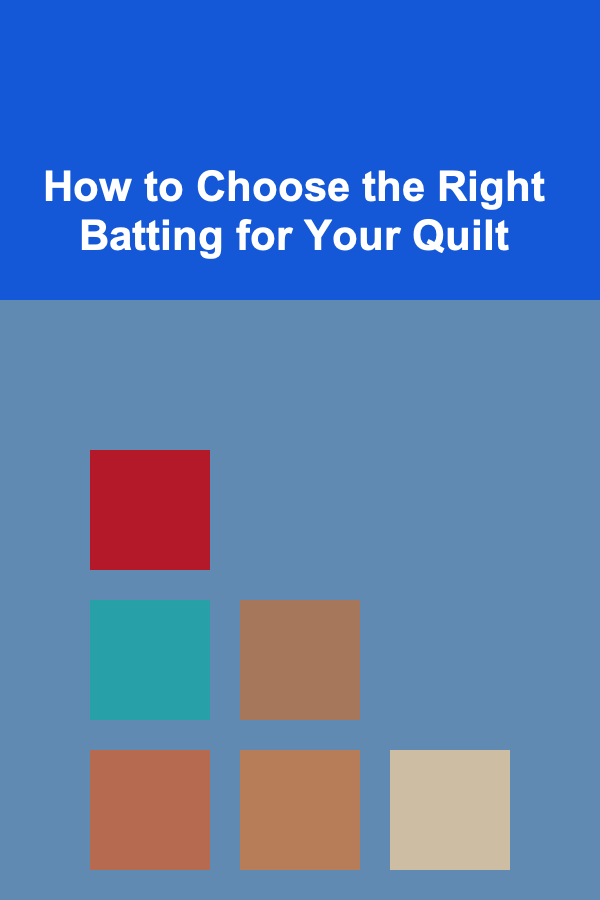
How to Choose the Right Batting for Your Quilt
ebook include PDF & Audio bundle (Micro Guide)
$12.99$11.99
Limited Time Offer! Order within the next:

When making a quilt, choosing the right batting is crucial to achieving the desired feel, durability, and overall appearance of the finished piece. Batting not only affects the quilt's comfort and warmth but also plays a key role in how well the quilting holds up over time. Whether you're a beginner or an experienced quilter, understanding the different types of batting and how they influence your project can make all the difference.
This guide will explore the various factors you need to consider when selecting batting for your quilt, including fiber content, loft, weight, shrinkage, and environmental considerations. By the end of this article, you'll have the knowledge to choose the perfect batting for your next quilt project.
What is Batting?
Batting is the middle layer of a quilt, sandwiched between the quilt top and the quilt backing. It provides warmth, structure, and texture to the quilt. Batting comes in a variety of fibers, thicknesses, and weights, and each type of batting has different properties that can affect the final outcome of your quilt.
When choosing batting, it's important to consider the following:
- Fabric content: The material used in the batting.
- Loft: The thickness or puffiness of the batting.
- Weight: How heavy or light the batting feels.
- Shrinkage: How much the batting will shrink after washing.
- Environmental factors: Sustainability and ethical production practices.
By understanding these key aspects, you can make an informed decision that best suits your quilt's purpose.
Types of Batting
There are several types of batting, each with its unique characteristics. The most common types of batting are made from cotton, polyester, wool, bamboo, and blends of different fibers. Let's look at each in detail.
1. Cotton Batting
Cotton is a popular choice for quilting, particularly for those who want a more traditional feel. It's soft, breathable, and easy to work with. Cotton batting provides a medium to low loft, making it ideal for projects where you want a flatter finish.
Characteristics:
- Soft and breathable: Ideal for quilts that will be used in warmer climates or for a natural feel.
- Low loft: Gives quilts a flatter appearance and is often used in traditional quilts.
- Durable: Cotton is strong and long-lasting, though it may compress over time.
- Shrinkage: Cotton batting has a tendency to shrink when washed, which can give quilts a slightly crinkled appearance.
Cotton batting is ideal for hand quilting and quilts that need a more soft, crinkly texture. It also offers a more vintage look, which is perfect for certain traditional or rustic designs.
2. Polyester Batting
Polyester batting is made from synthetic fibers and is a common choice for those who need a more affordable option. Polyester batting tends to have a higher loft than cotton and is often used when more puffiness or volume is desired.
Characteristics:
- High loft: Creates quilts with a puffier, more pronounced look.
- Lightweight: Makes quilts lighter and more comfortable.
- Resilient: Polyester batting doesn't compress as much over time, maintaining its loft and bulk.
- Non-shrinking: Polyester batting will not shrink in the wash, which is useful if you need a consistent finish.
Polyester batting is ideal for quilts that need more structure or volume, such as decorative quilts or those used in colder climates. However, it's less breathable than cotton, which may not be suitable for summer quilts.
3. Wool Batting
Wool batting is a natural material that offers warmth and softness. Wool is excellent for insulating quilts, making them cozy without being overly heavy.
Characteristics:
- Lightweight and warm: Wool provides warmth without being bulky, making it ideal for colder climates.
- Medium loft: Wool provides a moderate loft, giving quilts a fluffy yet soft texture.
- Natural resilience: Wool batting springs back into shape after washing, making it durable and long-lasting.
- Shrinkage: Wool batting can shrink slightly when washed, but not as much as cotton.
Wool batting is great for both hand and machine quilting, especially for those who want a lightweight yet warm quilt. It's also ideal for quilts that will be used as bed covers during colder months, thanks to its insulating properties.
4. Bamboo Batting
Bamboo batting is made from bamboo fibers and is an eco-friendly alternative to synthetic materials. It's known for its softness and lightness, making it perfect for creating quilts with a gentle drape.
Characteristics:
- Soft and breathable: Bamboo batting is very soft and provides excellent airflow, making it ideal for warmer quilts.
- Low loft: Similar to cotton, bamboo batting provides a flatter finish, which is ideal for modern quilts and those that need more structure.
- Eco-friendly: Bamboo is a sustainable and renewable resource, making it a good option for environmentally conscious quilters.
- Shrinkage: Bamboo batting may shrink slightly when washed, but not significantly.
Bamboo batting is perfect for lightweight quilts, such as summer or spring quilts, or those meant to be more decorative than warm.
5. Blended Batting
Blended batting combines fibers such as cotton and polyester or cotton and bamboo. These blends combine the benefits of both materials, giving you a balance of softness, durability, and loft.
Characteristics:
- Balanced properties: Depending on the blend, these battings can provide the softness of cotton with the durability and low maintenance of polyester.
- Medium loft: Blends tend to offer a middle ground in terms of loft, providing a good balance of volume without being too puffy.
- Shrinking properties vary: The shrinkage of blended battings will depend on the ratio of fibers used.
Blended batting is a versatile option that can be used for a wide range of quilt types. It's ideal for quilters who want a mix of the benefits of natural and synthetic fibers.
Loft and Weight of Batting
The loft of batting refers to its thickness or puffiness, while the weight indicates how heavy or light the batting feels. These two factors directly impact the texture and appearance of your quilt.
Low Loft
Low loft batting is thinner and provides a flatter finish. It's often used for quilts that require a more structured or less bulky appearance. Low loft batting works well for hand quilting and traditional quilt patterns, where a flatter, more defined stitching pattern is desired.
High Loft
High loft batting is thicker and puffier, making it ideal for quilts that need more volume and texture. High loft batting is often used for modern or contemporary quilts, especially those that feature heavy quilting or need extra warmth. It also gives quilts a more dramatic, plush feel.
The loft you choose will depend on your design and the overall look and feel you want for your quilt. If you're unsure, opting for a medium loft batting is a safe choice for a wide range of projects.
Shrinkage Considerations
One important factor to consider when selecting batting is shrinkage. Some batting types, particularly cotton and wool, will shrink slightly after washing, which can give your quilt a lovely crinkled effect. Other types, like polyester, do not shrink and maintain their smooth, consistent appearance.
If you want a more textured or vintage look for your quilt, choosing a batting that shrinks can be a great option. However, if you prefer a smoother, more modern finish, a non-shrinking batting may be better suited to your needs.
Before beginning your quilt, it's a good idea to test the batting by washing a small sample, especially if you are using a natural fiber like cotton or wool. This will help you understand how much the batting will shrink and allow you to adjust your quilting technique accordingly.
Environmental Considerations
If sustainability is important to you, there are several eco-friendly batting options available. Bamboo and cotton are both natural and renewable fibers, making them ideal choices for quilters who want to reduce their environmental impact. Some companies even offer batting made from recycled polyester, which is a great option for those seeking a more sustainable alternative to virgin polyester fibers.
Choosing an eco-friendly batting is a small but impactful way to reduce the environmental footprint of your quilt. Always check the labels for information on sourcing and production practices, and consider purchasing from brands that prioritize sustainability.
Conclusion
Choosing the right batting for your quilt can seem like a daunting task, but with the right knowledge, it can become a straightforward and enjoyable part of your quilting process. By considering the fiber content, loft, weight, shrinkage, and environmental factors, you can select the batting that best fits your project's needs.
Each type of batting offers unique benefits, whether you're looking for warmth, texture, sustainability, or ease of care. Take the time to experiment with different options, and don't be afraid to mix and match batting types to create quilts that are as unique as you are.
With the right batting, you'll be one step closer to creating beautiful, functional quilts that bring comfort and warmth to your home. Happy quilting!
Reading More From Our Other Websites
- [Home Soundproofing 101] How to Create a Professional Home Theater with Soundproofing Tips
- [Organization Tip 101] How to Involve Kids in Organizing Your Yard Sale
- [Organization Tip 101] How to Capture Special Moments Beyond the Wedding Day
- [Personal Financial Planning 101] How to Build a Resilient Financial Future by Integrating Insights from Personal Finance Books into Your Daily Money Habits
- [Reading Habit Tip 101] The Science Behind Reading: Why It Improves Memory and Critical Thinking
- [Organization Tip 101] How to Implement a Referral Program for New Tenants
- [Organization Tip 101] Best Organization Tools for Writers and Authors
- [Home Family Activity 101] How to Experiment with Homemade Slime Recipes for Sensory Play and STEM Learning
- [Organization Tip 101] How to Categorize Vintage vs. Modern Jewelry Effectively
- [Simple Life Tip 101] Best Simple Recipes Using Only One Pot and Five Ingredients

How to Organize a Travel Kit for Pets
Read More
How to Store Seasonal Clothing Without Taking Up Too Much Space
Read MoreMarketing Tips for Selling Digital Health Trackers
Read More
When to Discuss Salary During the Job Interview Process
Read More
How To Choose Wine for Winter Warmth
Read More
How To Find Books That Teach You Something New
Read MoreOther Products

How to Organize a Travel Kit for Pets
Read More
How to Store Seasonal Clothing Without Taking Up Too Much Space
Read MoreMarketing Tips for Selling Digital Health Trackers
Read More
When to Discuss Salary During the Job Interview Process
Read More
How To Choose Wine for Winter Warmth
Read More